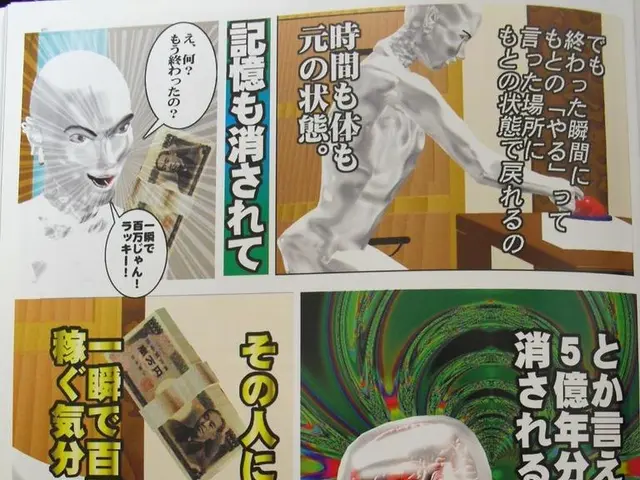Diving into the Distinctions and Overlaps: An In-depth Examination of Mania and Depression
Bipolar disorder, a complex mental health condition, is known for its extreme mood swings between mania and depression. This article aims to shed light on the differences between mania and hypomania, their impacts, and the treatment approaches for each.
Mania, a state of heightened mood, energy, and activity, can be both exhilarating and dangerous. It is characterized by symptoms such as elevated or irritable mood, increased energy and activity levels, decreased need for sleep, racing thoughts and rapid speech, grandiose beliefs or inflated self-esteem, increased goal-directed activity or psychomotor agitation, and engaging in risky or pleasurable activities with potential for negative consequences. Full-blown mania can lead to significant disruptions in work, relationships, and overall well-being, and may even involve psychotic symptoms like delusions or hallucinations.
On the other hand, hypomania is a milder form of mania that doesn't typically cause severe impairment in daily functioning. While it involves an elevated mood and increased activity, it generally allows individuals to maintain work and relationships, though changes may be noticeable to others.
The main differences between mania and hypomania relate to severity, duration, functional impact, and presence of psychotic symptoms. Mania is more intense and severe than hypomania, with manic episodes lasting at least one week (or less if hospitalization is required), while hypomanic episodes last at least four consecutive days and do not warrant hospitalization. Mania often leads to noticeable problems in work, relationships, and daily activities, potentially putting individuals or others at risk, whereas hypomania involves elevated mood and increased activity but generally allows individuals to maintain work and relationships. Psychotic features such as delusions or hallucinations can occur during mania but not during hypomania.
Depression, the other pole of bipolar disorder, is a state of persistent low mood, decreased energy, and loss of interest or pleasure in activities. Symptoms include persistent sad, anxious, or empty mood, loss of interest or pleasure in activities once enjoyed, significant changes in appetite or weight, sleep disturbances (insomnia or hypersomnia), fatigue or loss of energy, feelings of worthlessness or excessive guilt, difficulty concentrating or making decisions, and recurrent thoughts of death or suicide.
Both mania and depression can significantly impact an individual's ability to function in daily life, affecting work, relationships, and overall well-being. Accurate diagnosis and appropriate treatment are crucial for managing both manic and depressive episodes.
In treating bipolar disorder, an integrated approach is often necessary to address both manic and depressive episodes. This may involve a combination of mood stabilizers, antipsychotics, and psychotherapy. Treatment options for mania typically include mood stabilizers, antipsychotic medications, psychoeducation and cognitive-behavioral therapy, and in severe cases, hospitalization. For depression, treatment options often include antidepressant medications, psychotherapy, and electroconvulsive therapy for severe cases.
Understanding the nuances between different mood disorders is essential for both patients and healthcare providers to lead to more accurate diagnoses and more effective treatment strategies. The Diagnostic and Statistical Manual of Mental Disorders (DSM-5) provides specific criteria for diagnosing manic, hypomanic, and depressive episodes.
It's crucial for individuals experiencing symptoms of mania or depression to seek professional help for proper diagnosis and treatment. Both mania and depression have been linked to genetic predispositions and can be triggered or exacerbated by environmental stressors.
In conclusion, bipolar disorder is a complex condition characterized by extreme mood swings between mania and depression. Understanding the differences between mania and hypomania, and their impacts, is crucial for accurate diagnosis, effective treatment, and improved quality of life for those affected by bipolar disorder.
- The field of psychology has been instrumental in understanding the complexities of bipolar disorder, a mental health condition known for its extreme mood swings.
- Sleep patterns can be significantly affected in both mania and depression, two poles of bipolar disorder, with mania leading to decreased need for sleep while depression might result in insomnia or hypersomnia.
- Mood disorders, including bipolar disorder, can substantially impact an individual's personal life, career, and overall health-and-wellness.
- Self-care practices, like fitness-and-exercise, nutrition, and skin-care, can play a crucial role in managing symptoms associated with bipolar disorder and promoting personal-growth.
- Therapies-and-treatments for bipolar disorder often involve the use of medicare, such as mood stabilizers, antipsychotics, and antidepressants, in combination with psychotherapy like cognitive-behavioral therapy.
- Stress, a common trigger for various mental health issues, can exacerbate symptoms in individuals with bipolar disorder, making stress management an essential component of self-care.
- Education-and-self-development, both formal and informal, can provide valuable insights into understanding and managing bipolar disorder, empowering individuals to take control of their mental health.
- Chronic-diseases and cancer may also have mental health consequences, including increased anxiety and depression, and may interact with bipolar disorder, thus requiring careful consideration in treatment approaches.
- Neurological-disorders, skin-conditions, and other medical-conditions may mirror some of the symptoms observed in bipolar disorder or share similar underlying causes, making it essential to consider a comprehensive approach to a diagnosis.
- The workplace-wellness movement has gained momentum in acknowledging mental health as a crucial aspect of overall employee well-being, encouraging organizations to offer resources and support for those affected by mental health conditions like bipolar disorder.
- Anxiety is a common symptom in both mania and depression, with mania leading to worries or concerns about one's grandiose ideas or excessive involvement in activities, and depression resulting in persistent feelings of anxiety or empty mood.
- In some cases, bipolar disorder may manifest alongside other mental health issues, such as anxiety disorders, further complicating diagnosis and treatment.
- Recognizing and understanding the various aspects of mental health, including conditions like bipolar disorder, is essential for our collective pursuit of improved education-and-self-development, personal-growth, and career-development.




